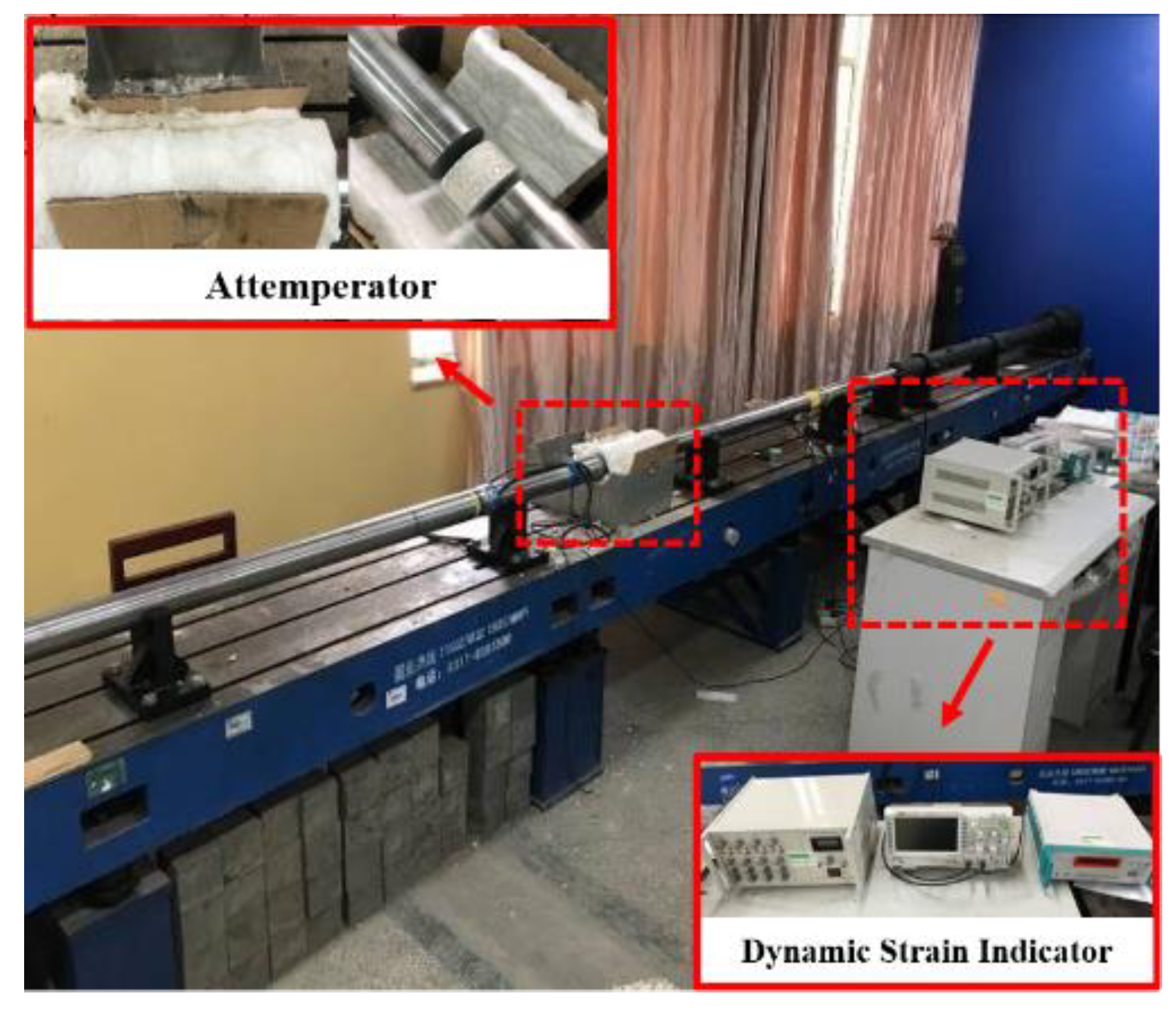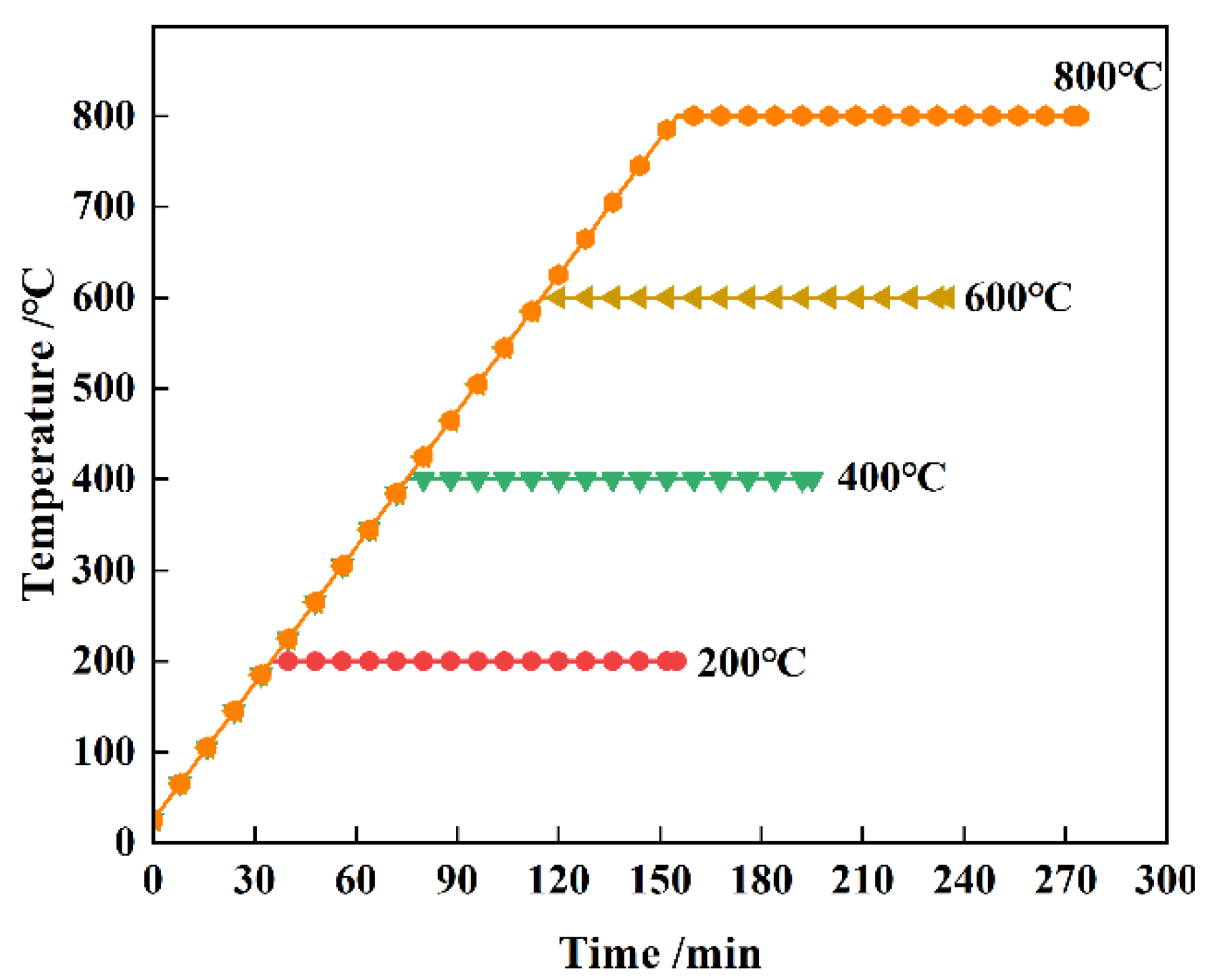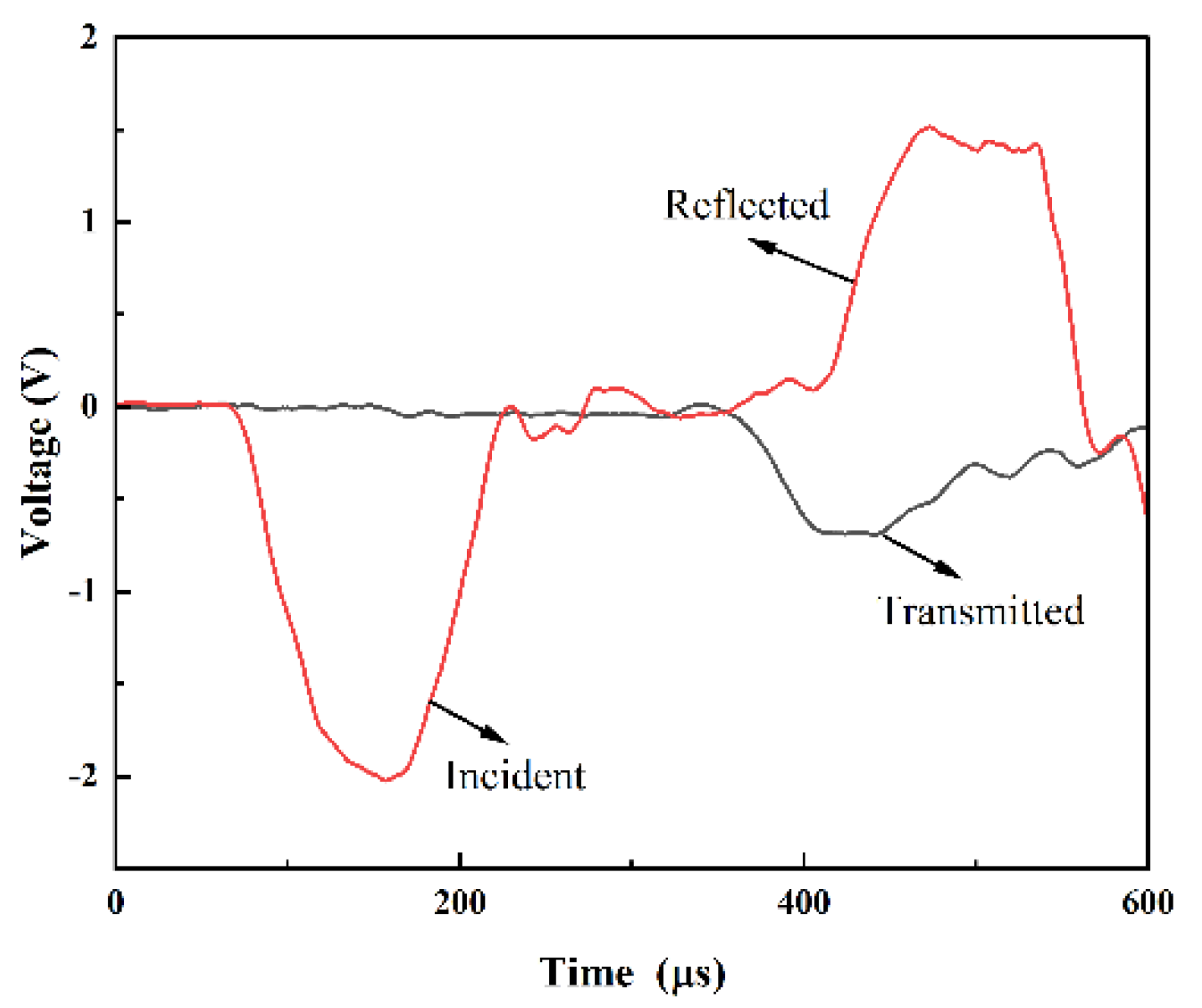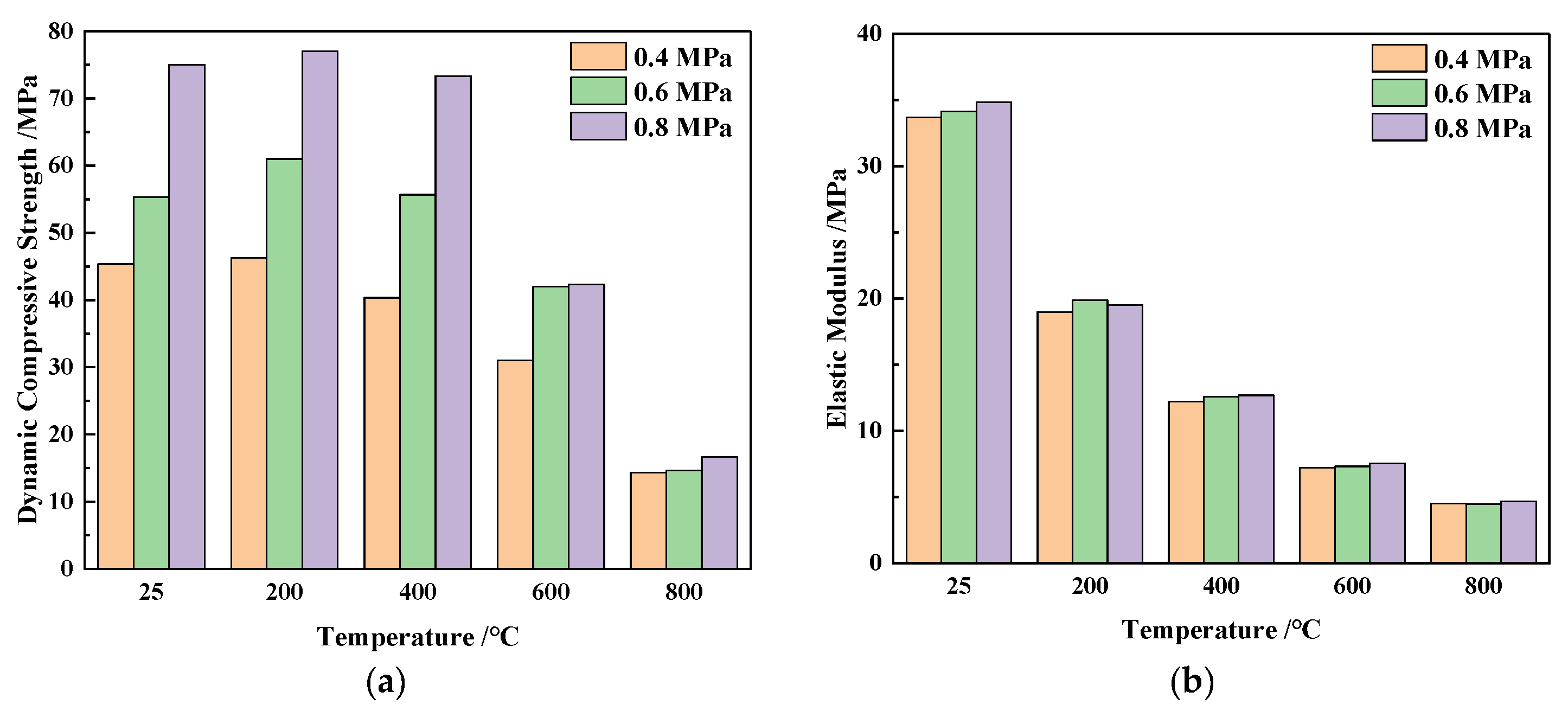Study on Dynamic Constitutive Model of Polypropylene Concrete under Real-Time High-Temperature Conditions
Abstract
:1. Introduction
2. The Modified Dynamic Constitutive Model of Polypropylene Concrete
2.1. The Modified Z-W-T Nonlinear Viscoelastic Model
- The initial stage of the stress–strain curve of concrete under impact loading was nearly linear elastic [29], meaning that part I of Equation (1) can be approximately converted into a linear polynomial, as shown in Equation (2).
- Part Ⅱ of Equation (1) consists of two Maxwell element relaxation functions and have large differences in the relaxation time (θ1 and θ2), where the Maxwell element with relaxation time θ1 describes the mechanical behavior of the material at a low strain rate, and the Maxwell element with relaxation time θ2 describes the viscoelastic behavior of the material at a high strain rate (the order of magnitude for θ1 and θ2 are 10~102 s and 10−4~10−6 s, respectively). Other studies have shown that the mechanical properties of concrete material were obviously affected by the strain rate especially and they were sensitive at high strain rates [26].The strain rate of polypropylene concrete under the impact load 102 s−1 [30] resulted in a short observation time; in this case, the low-frequency Maxwell element could not be relaxed, showing linear springs characteristics, whereas the Maxwell element with a relaxation time of θ2 described the viscoelastic mechanical behavior of the material under high strain rate conditions. Therefore, a simple spring can be used to replace the low-frequency Maxwell element in the Z-W-T non-linear viscoelastic model in this situation (Equation (3)), and under a high strain rate, the Z-W-T nonlinear viscoelastic model can be expressed by Figure 1b. Equation (4) shows the equivalent treatment of two parallel elastomers and the adjusted Z-W-T nonlinear viscoelastic model (Equation (5)) is represented in Figure 1c. Although the final expression form of the modified Z-W-T nonlinear viscoelasticity model was similar to that of the Kelvin–Voigt model [31], the derivation processes of the two models were not the same.
- As a heterogeneous material, polypropylene concrete contains a large number of random polypropylene fibers and pores [32]. Therefore, damage factors should be considered when studying dynamic damage constitutive models of polypropylene concrete under impact load and thermal conditions. From the perspective of continuous damage mechanics, polypropylene concrete is assumed to be a continuous medium [33]. The composite damage amount D was introduced to measure the degree of damage experienced by the polypropylene concrete. In this case, Equation (6) describes a relationship according to the principle of strain equivalence [34]. Additionally, the modified Z-W-T non-linear viscoelastic model with the damage variable D (Equation (7)) can be obtained by substituting Equation (5) into Equation (6).where σa represents effective stress, σr represents the nominal stress, and D represents the damage variable.
2.2. Damage Variable
3. Experiment and Results
3.1. Experimental Material
3.2. Experimental Equipment
3.3. The Solution of Real-Time High-Temperature Experiments
3.4. Experiment Theory
3.5. Typical Waveform and Dynamic Stress Equalization
3.6. The Relationship between Impact Air Pressure Level and Impact Velocity
3.7. Results of Experiment
4. Discussion
4.1. Effect of Thermal Conditions on Dynamic Mechanical Properties of Polypropylene Fiber Concrete
4.2. Validation of Constitutive Model and Determination of Parameters
5. Conclusions
Author Contributions
Funding
Institutional Review Board Statement
Informed Consent Statement
Data Availability Statement
Conflicts of Interest
References
- Wu, H.; Lin, X.; Zhou, A. A review of mechanical properties of fibre reinforced concrete at elevated temperatures. Cem. Concr. Res. 2020, 135, 106117. [Google Scholar] [CrossRef]
- Yu, Q.; Zhuang, W.; Shi, C. Research progress on the dynamic compressive properties of ultra-high performance concrete under high strain rates. Cem. Concr. Compos. 2021, 124, 104258. [Google Scholar] [CrossRef]
- Ramezani, M.; Kim, Y.H.; Sun, Z. Elastic modulus formulation of cementitious materials incorporating carbon nanotubes: Probabilistic approach. Constr. Build. Mater. 2020, 274, 122092. [Google Scholar] [CrossRef]
- Ramezani, M.; Kim, Y.H.; Sun, Z. Mechanical properties of carbon-nanotube-reinforced cementitious materials: Database and statistical analysis. Mag. Concr. Res. 2020, 72, 1047–1071. [Google Scholar] [CrossRef]
- Ramezani, M.; Kim, Y.H.; Sun, Z. Probabilistic model for flexural strength of carbon nanotube reinforced cement-based materials. Compos. Struct. 2020, 253, 112748. [Google Scholar] [CrossRef]
- Xu, F.; Wang, S.; Li, T.; Liu, B.; Li, B.; Zhou, Y. Mechanical properties and pore structure of recycled aggregate concrete made with iron ore tailings and polypropylene fibers. J. Build. Eng. 2020, 33, 101572. [Google Scholar] [CrossRef]
- Chen, Y.; Cen, G.; Cui, Y. Comparative analysis on the anti-wheel impact performance of steel fiber and reticular polypropylene synthetic fiber reinforced airport pavement concrete under elevated temperature aging environment. Constr. Build. Mater. 2018, 192, 818–835. [Google Scholar] [CrossRef]
- Afroughsabet, V.; Ozbakkaloglu, T. Mechanical and durability properties of high-strength concrete containing steel and polypropylene fibers. Constr. Build. Mater. 2015, 94, 73–82. [Google Scholar] [CrossRef]
- Tan, S.; Moinuddin, K. Systematic review of human and organizational risks for probabilistic risk analysis in high-rise buildings. Reliab. Eng. Syst. Saf. 2019, 188, 233–250. [Google Scholar] [CrossRef]
- Ulm, F.-J.; Coussy, O.; Bažant, Z.P. The “Chunnel” Fire. I: Chemoplastic Softening in Rapidly Heated Concrete. J. Eng. Mech. 1999, 125, 272–282. [Google Scholar] [CrossRef]
- Feih, S.; Mathys, Z.; Gibson, A.G.; Mouritz, A.P. Modelling the tension and compression strengths of polymer laminates in fire. Compos. Sci. Technol. 2007, 67, 551–564. [Google Scholar] [CrossRef]
- Sukontasukkul, P.; Pomchiengpin, W.; Songpiriyakij, S. Post-crack (or post-peak) flexural response and toughness of fiber reinforced concrete after exposure to high temperature. Constr. Build. Mater. 2010, 24, 1967–1974. [Google Scholar] [CrossRef]
- Ramezani, M.; Kim, Y.H.; Sun, Z. Modeling the mechanical properties of cementitious materials containing CNTs. Cem. Concr. Compos. 2019, 104, 103347. [Google Scholar] [CrossRef]
- Tang, C.-W. Modeling Uniaxial Bond Stress–Slip Behavior of Reinforcing Bars Embedded in Concrete with Different Strengths. Materials 2021, 14, 783. [Google Scholar] [CrossRef]
- Li, Y.; Yang, E.-H.; Tan, K.H. Flexural behavior of ultra-high performance hybrid fiber reinforced concrete at the ambient and elevated temperature. Constr. Build. Mater. 2020, 250, 118487. [Google Scholar] [CrossRef]
- Park, K.S.; Shoukat, T.; Yoo, P.J.; Lee, S.H. Strengthening of hybrid glass fiber reinforced recycled hot-mix asphalt mixtures. Constr. Build. Mater. 2020, 258, 118947. [Google Scholar] [CrossRef]
- Behnood, A.; Ghandehari, M. Comparison of compressive and splitting tensile strength of high-strength concrete with and without polypropylene fibers heated to high temperatures. Fire Saf. J. 2009, 44, 1015–1022. [Google Scholar] [CrossRef]
- Fu, Q.; Bu, M.; Xu, W.; Chen, L.; Li, D.; He, J.; Kou, H.; Li, H. Comparative analysis of dynamic constitutive response of hybrid fibre-reinforced concrete with different matrix strengths. Int. J. Impact Eng. 2020, 148, 103763. [Google Scholar] [CrossRef]
- Wen, Y.; Huang, R.; Li, P.; Ma, J.; Xiao, K. Damage Evolution Equation of Concrete Materials at High Temperatures and High Strain Rates. Chin. J. High Press. Phys. 2021, 35, 54–63. (In Chinese) [Google Scholar]
- Wang, B.; Wang, F.; Wang, Q. Damage constitutive models of concrete under the coupling action of freeze–thaw cycles and load based on Lemaitre assumption. Constr. Build. Mater. 2018, 173, 332–341. [Google Scholar] [CrossRef]
- Zhu, Z.; Xu, D.; Wang, L. Thermoviscoelastic Constitutive Equation and Time-Temperature Equivalence of Epoxy Resin at High Strain Rates. J. Ningbo Univ. (Nat. Sci. Eng. Ed.) 1988, 1, 58–68. [Google Scholar]
- Zhu, Z.-W.; Ning, J.-G.; Liu, X. Dynamic Mechanical Behaviors of Soil under Impact Loads. Chin. J. High Press. Phys. 2011, 25, 444–450. [Google Scholar]
- Liu, H.; Ning, J. Constitutive model for concrete subjected to impact loading. J. Southeast Univ. (Engl. Ed.) 2012, 28, 79–84. [Google Scholar]
- Xie, L.; Zhao, G.; Meng, X. Research on Damage Viscoelastic Dynamic Constitutive Model of Soft Rock and Concrete Materials. Chin. J. Rock Mech. Eng. 2013, 32, 857–864. [Google Scholar]
- Zhang, H.; Wang, B.; Xie, A.; Qi, Y. Experimental study on dynamic mechanical properties and constitutive model of basalt fiber reinforced concrete. Constr. Build. Mater. 2017, 152, 154–167. [Google Scholar] [CrossRef]
- Yang, W.W.; Liu, H.F.; Ning, J.G. Dynamic Constitutive Model of Concrete. Adv. Mater. Res. 2012, 450, 379–382. [Google Scholar] [CrossRef]
- Zhai, Y.; Li, Y.; Li, Y.; Wang, S.; Liu, Y.; Song, K.I. Impact of high-temperature-water cooling damage on the mechanical properties of concrete. Constr. Build. Mater. 2019, 215, 233–243. [Google Scholar] [CrossRef]
- Wang, L. Adcanced in Impact Dynamics; China University of Science and Technology Press: Hefei, China, 1992. [Google Scholar]
- Khosravani, M.R.; Weinberg, K. A review on split Hopkinson bar experiments on the dynamic characterisation of concrete. Constr. Build. Mater. 2018, 190, 1264–1283. [Google Scholar] [CrossRef]
- Zhang, H.; Wang, L.; Zheng, K.; Bakura, T.J.; Jibrin, T.; Totakhil, P.G. Research on compressive impact dynamic behavior and constitutive model of polypropylene fiber reinforced concrete. Constr. Build. Mater. 2018, 187, 584–595. [Google Scholar] [CrossRef]
- Farno, E.; Baudez, J.-C.; Eshtiaghi, N. Comparison between classical Kelvin-Voigt and fractional derivative Kelvin-Voigt models in prediction of linear viscoelastic behaviour of waste activated sludge. Sci. Total Environ. 2018, 613–614, 1031–1036. [Google Scholar] [CrossRef]
- Gencel, O.; Kazmi, S.M.S.; Munir, M.J.; Kaplan, G.; Bayraktar, O.Y.; Yarar, D.O.; Karimipour, A.; Ahmad, M.R. Influence of bottom ash and polypropylene fibers on the physico-mechanical, durability and thermal performance of foam concrete: An experimental investigation. Constr. Build. Mater. 2021, 306, 124887. [Google Scholar] [CrossRef]
- Xi, Y.; Eskandari-Ghadi, M.; Suwito; Sture, S. Damage Theory Based on Composite Mechanics. J. Eng. Mech. 2006, 132, 1195–1204. [Google Scholar] [CrossRef]
- Lemaitre, J. A Course on Damage Mechanics; Springer: Berlin, Heidelberg, 1992. [Google Scholar]
- Wang, M.; Hu, Y.; Tong, J.; Wang, Q.; Wang, Y.; Dong, C. Experimental study on shear mechanical properties and thermal damage model of shotcrete-rock interfaces under variable high temperatures. Chin. J. Rock Mech. Eng. 2019, 38, 63–75. [Google Scholar]
- Yao, Y.; Guo, H.; Tan, K. An elastoplastic damage constitutive model of concrete considering the effects of dehydration and pore pressure at high temperatures. Mater. Struct. 2020, 53, 19. [Google Scholar] [CrossRef]
- Zhao, D.; Zhao, R.; Jia, P.; Liu, H. Microstructure and fatigue performance of high strength concrete under compression after exposure to elevated temperatures. Eur. J. Environ. Civ. Eng. 2019, 23, 1–25. [Google Scholar] [CrossRef]
- Huang, S.; Xia, K. Effect of heat-treatment on the dynamic compressive strength of Longyou sandstone. Eng. Geol. 2015, 191, 1–7. [Google Scholar] [CrossRef]
- Gao, G. Influence and Revision of Transverse Inertia Effect and Pressure Hardening Effect on Strain-Rate Hardening Effect of Compressive Strength of Concrete. Trans. Beijing Inst. Technol. 2020, 40, 135–149. [Google Scholar]
- Luo, Y.; Li, X.; Wang, Q.; Yang, J. Research Progress in Dynamic Constitutive Relationship of Polyvinyl Alcohol Fiber Reinforced Cement Matrix Composites (ECC). Contemp. Chem. Ind. 2021, 50, 1690–1697. [Google Scholar]
- Zhai, Y.; Zhao, R.; Li, Y.; Li, Y.; Meng, F.; Wang, T. Stochastic inversion method for dynamic constitutive model of rock materials based on improved DREAM. Int. J. Impact Eng. 2021, 147, 103739. [Google Scholar] [CrossRef]
- Xu, S.; Wu, P.; Zhou, F.; Jiang, X.; Chen, B.K.; Li, Q.H. A dynamic constitutive model of ultra high toughness cementitious composites. J. Zhejiang Univ.-Sci. A 2020, 21, 939–960. [Google Scholar] [CrossRef]
- Fu, Q.; Xu, W.; Bu, M.; Su, L.; He, J.; Kou, H. A Simplified Dynamic Constitutive Model for Bfrcac under Confining Pressure Considering the Coupling Effect of Fibre Reinforcement and Mechanical Damage. Compos. Struct. 2021, 268, 113944. [Google Scholar] [CrossRef]
- Wang, Z.-L.; Liu, Y.-S.; Shen, R. Stress–strain relationship of steel fiber-reinforced concrete under dynamic compression. Constr. Build. Mater. 2008, 22, 811–819. [Google Scholar] [CrossRef]
- Yin, T.; Wang, P.; Yang, J.; Li, X. Mechanical Behaviors and Damage Constitutive Model of Thermally Treated Sandstone under Impact Loading. IEEE Access 2018, 6, 72047–72062. [Google Scholar] [CrossRef]
- Zheng, Y.; Shi, H.; Liu, X.; Zhang, W. Failure characteristics and constitutive model of coal rock at different strain rates. Explos. Shock. Waves 2021, 41, 45–57. [Google Scholar]
- Zhang, H.; Liu, Y.; Sun, H.; Wu, S. Transient dynamic behavior of polypropylene fiber reinforced mortar under compressive impact loading. Constr. Build. Mater. 2016, 111, 30–42. [Google Scholar] [CrossRef]
- Huo, J.; He, Y.; Xiao, L.; Chen, B.S. Experimental Study on Dynamic Behaviours of Concrete After Exposure to High Temperatures Up to 700 a Degrees C. Mater. Struct. 2013, 46, 255–265. [Google Scholar] [CrossRef]
- Bentz, D.P.; Flynn, D.R.; Kim, J.H.; Zarr, R.R. A slug calorimeter for evaluating the thermal performance of fire resistive materials. Fire Mater. 2005, 30, 257–270. [Google Scholar] [CrossRef]
- Lucio-Martin, T.; Roig-Flores, M.; Izquierdo, M.; Alonso, M. Thermal conductivity of concrete at high temperatures for thermal energy storage applications: Experimental analysis. Sol. Energy 2020, 214, 430–442. [Google Scholar] [CrossRef]
- Zhang, T.; Zhang, Y.; Zhu, H.; Yan, Z. Characterizing the thermal properties of hybrid polypropylene-steel fiber reinforced concrete under heat exposure: Insights into fiber geometry and orientation distribution. Compos. Struct. 2021, 275, 114457. [Google Scholar] [CrossRef]
- Tasdemir, C.; Sengul, O.; Tasdemir, M.A. A comparative study on the thermal conductivities and mechanical properties of lightweight concretes. Energy Build. 2017, 151, 469–475. [Google Scholar] [CrossRef]
- Song, L.; Hu, S.-S. Stress uniformity and constant strain rate in SHPB test. Explos. Shock. Waves 2005, 3, 207–216. [Google Scholar]
- Song, L.; Hu, S.-S. Two-wave and three-wave method in SHPB data processing. Explos. Shock. Waves 2005, 4, 368–373. [Google Scholar]
- Merle, R.; Zhao, H. On the errors associated with the use of large diameter SHPB, correction for radially non-uniform distribution of stress and particle velocity in SHPB testing. Int. J. Impact Eng. 2006, 32, 1964–1980. [Google Scholar] [CrossRef]
- Yin, T.; Wang, C.; Wu, Y.; Wu, B. A waveform modification method for testing dynamic properties of rock under high temperature. J. Rock Mech. Geotech. Eng. 2021, 13, 833–844. [Google Scholar] [CrossRef]
- Yang, Y.; Wu, C.; Liu, Z.; Liang, X.; Xu, S. Experimental Investigation on the Dynamic Behaviors of UHPFRC after Exposure to High Temperature. Constr. Build. Mater. 2019, 227, 116679. [Google Scholar] [CrossRef]
- Qian, Y.; Yang, D.; Xia, Y.; Gao, H.; Ma, Z. Transport Properties and Resistance Improvement of Ultra-High Performance Concrete (UHPC) after Exposure to Elevated Temperatures. Buildings 2021, 11, 416. [Google Scholar] [CrossRef]
- Li, Y.; Du, P.; Tan, K.H. Fire resistance of ultra-high performance concrete columns subjected to axial and eccentric loading. Eng. Struct. 2021, 248, 113158. [Google Scholar] [CrossRef]
- Jiang, H.-P.; Jiang, A.-N.; Yang, X.-R. Statistical damage constitutive model of high temperature rock based on Weibull distribution and its verification. Rock Soil Mech. 2021, 42, 1894–1902. [Google Scholar]










| Characteristics | Density (g/cm3) | Length (mm) | Equivalent Diameter | Melting Point (°C) | Elongation at Break (%) | Elastic Modulus (MPa) |
|---|---|---|---|---|---|---|
| Parameter | 1.18 | 3–9 | 9–30 um | 220 | ≥15–25 | ≥13,000 |
| Water | Cement | Fly Ash | Silica Fume | Sand | Pebble | Polypropylene Fiber | Water Reducing Admixture |
|---|---|---|---|---|---|---|---|
| 160 | 234 | 108 | 18 | 714 | 1166 | 1 | 7.2 |
| Material | Density | Elastic Modulus | Poisson Ratio |
|---|---|---|---|
| 45GrNiMoVA | 7794 g/cm3 | 211 GPa | 0.285 |
| Target | Removal | Before Experiment | After Experiment | Drop Rate (%) |
|---|---|---|---|---|
| 700 | 704 | 683 | 672 | 4.55 |
| 500 | 503 | 489 | 483 | 3.98 |
| 300 | 306 | 297 | 290 | 5.23 |
| 100 | 105 | 101 | 98 | 6.67 |
| Impact Air Pressure (MPa) | Impact Velocity (m/s) | Average Impact Velocity (m/s) |
|---|---|---|
| 0.4 | 5.6 | 5.5 |
| 5.3 | ||
| 5.5 | ||
| 0.6 | 7.3 | 7.5 |
| 7.8 | ||
| 7.4 | ||
| 0.8 | 9.2 | 9.5 |
| 9.7 | ||
| 9.6 |
| Average Impact Air Pressure | Temperature Grade | Calculated Parameters | Fitting Parameters | R2 | |||
|---|---|---|---|---|---|---|---|
| m | F0 | Ea | E2 | ||||
| 0.4 | 25 | 1.36 | 43.23 | 1.27 | −1.39 | 1.79 | 0.925 |
| 200 | 1.69 | 41.61 | 5.25 | −4.51 | 1.56 | 0.948 | |
| 400 | 2.11 | 33.65 | 3.19 | −3.35 | 2.45 | 0.964 | |
| 600 | 4.01 | 20.51 | 2.21 | −1.87 | 3.60 | 0.915 | |
| 800 | 3.92 | 9.56 | 1.48 | −2.65 | 2.67 | 0.939 | |
| 0.6 | 25 | 1.41 | 52.39 | 1.54 | −3.32 | 2.41 | 0.959 |
| 200 | 1.97 | 51.16 | 4.87 | −1.65 | 2.86 | 0.926 | |
| 400 | 3.47 | 38.76 | 4.36 | −3.78 | 3.75 | 0.959 | |
| 600 | 4.48 | 25.35 | 4.23 | −5.23 | 3.55 | 0.927 | |
| 800 | 4.29 | 8.61 | 6.79 | −5.11 | 1.37 | 0.949 | |
| 25 | 1.94 | 64.42 | 1.76 | −2.45 | 1.27 | 0.913 | |
| 0.8 | 200 | 2.58 | 61.15 | 1.53 | −3.12 | 1.53 | 0.914 |
| 400 | 3.66 | 45.36 | 1.04 | −2.12 | 3.69 | 0.981 | |
| 600 | 4.12 | 37.61 | 1.86 | −3.13 | 5.49 | 0.971 | |
| 800 | 4.24 | 21.23 | 1.29 | −2.76 | 1.42 | 0.915 | |
Publisher’s Note: MDPI stays neutral with regard to jurisdictional claims in published maps and institutional affiliations. |
© 2022 by the authors. Licensee MDPI, Basel, Switzerland. This article is an open access article distributed under the terms and conditions of the Creative Commons Attribution (CC BY) license (https://creativecommons.org/licenses/by/4.0/).
Share and Cite
Li, R.; Liu, L.; An, H.; Wang, Y. Study on Dynamic Constitutive Model of Polypropylene Concrete under Real-Time High-Temperature Conditions. Appl. Sci. 2022, 12, 1482. https://doi.org/10.3390/app12031482
Li R, Liu L, An H, Wang Y. Study on Dynamic Constitutive Model of Polypropylene Concrete under Real-Time High-Temperature Conditions. Applied Sciences. 2022; 12(3):1482. https://doi.org/10.3390/app12031482
Chicago/Turabian StyleLi, Rui, Lei Liu, Huaming An, and Ya Wang. 2022. "Study on Dynamic Constitutive Model of Polypropylene Concrete under Real-Time High-Temperature Conditions" Applied Sciences 12, no. 3: 1482. https://doi.org/10.3390/app12031482






